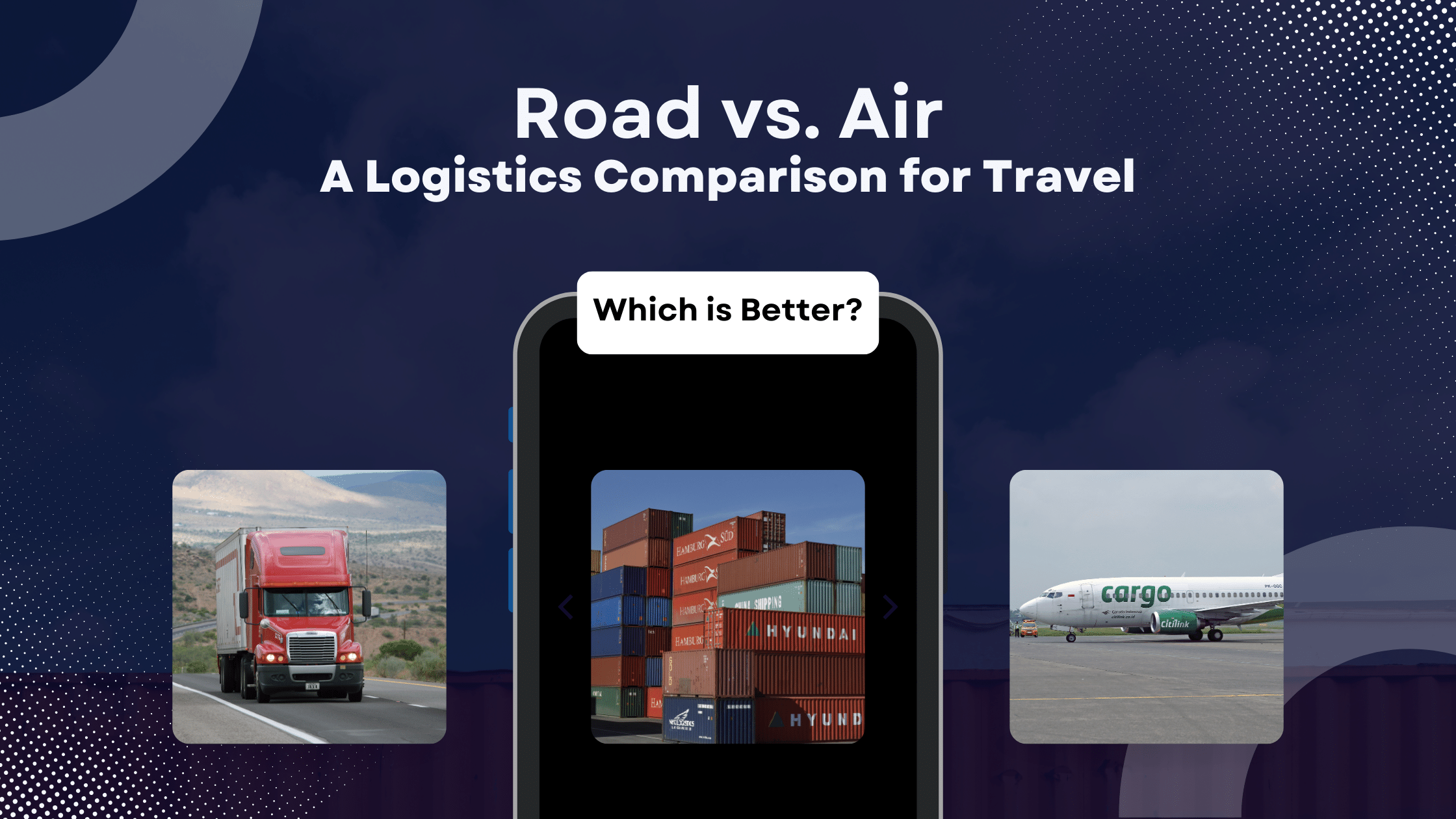Logistics is a key driver in global trade, where the mode of transportation impacts everything from delivery speed to cost and reliability. Choosing the right mode is not just about moving goods; it’s a strategic decision that can determine the success of a supply chain.
This blog provides a detailed comparison between road and air transport from a logistics perspective, offering insights for professionals and decision-makers in the logistics industry.
Road Logistics
Characteristics:
Road transport is versatile and widely accessible:
- Infrastructure Requirements: Includes everything from major highways for cross-country transport to local roads for last-mile deliveries, emphasizing the need for a robust and well-maintained road network.
- Vehicle Types: Encompasses a variety of vehicles, including small delivery vans, medium trucks, and large freight trucks, each suited for different types of cargo and distances.
- Regulatory Environment: Involves laws and regulations that govern aspects like vehicle safety standards, driver working hours, and emission controls, impacting operational efficiency.
Advantages:
The strengths of road logistics are significant:
- Flexibility in Routing: Road transport offers route customization, allowing for adjustments in response to traffic conditions, delivery schedules, or customer requests.
- Suitability for Short to Medium Distances: Ideal for intra-city or regional deliveries where the speed and convenience of road transport are unmatched.
- Ease of Tracking: Modern GPS and tracking technologies enable real-time monitoring of goods, enhancing transparency and control over the supply chain.
- Door-to-Door Delivery: Direct delivery capability from the origin to the destination without intermediate handling, reducing the risk of damage and delays.
Challenges:
However, it faces several obstacles:
- Traffic Congestion: Can lead to significant delays, particularly in urban areas, affecting delivery times and operational efficiency.
- Longer Transit Times for Long Distances: Not as time-efficient for long-distance deliveries compared to air transport, which can be a drawback for time-sensitive goods.
- Higher Risk of Goods Damage or Accidents: Road transport is more susceptible to accidents and damage due to frequent loading and unloading, road conditions, and longer exposure times.
Air Logistics
Characteristics:
Air transport is fast and far-reaching:
- Airport Infrastructure: Requires access to airports, which involves considerations of location, runway capacity, and cargo handling facilities.
- Aircraft Types: Ranges from small cargo planes for quick, less bulky shipments to large freighters for substantial volumes, each offering different capabilities and cost implications.
- Air Freight Handling: Involves complex logistics including cargo loading, security checks, and coordination with airport authorities, all under strict regulatory compliance for safety and security.
Advantages:
The benefits of air transport are clear:
- Speed: Paramount for urgent or perishable goods, offering the fastest mode of transportation over long distances.
- Long Distance Efficiency: Ideal for global logistics, making it possible to connect distant locations within hours.
- High-Level Security: Reduced risk of theft or damage, significant for high-value or sensitive cargo.
Challenges:
But it comes with its own set of challenges:
- Higher Costs: Generally more expensive due to fuel costs, airport fees, and specialized handling requirements.
- Weather Dependency: Susceptible to delays and cancellations due to adverse weather, which can disrupt schedules and lead to additional costs.
- Limited Cargo Capacity: Compared to road transport, air freight has restrictions on cargo size and weight, requiring careful planning and optimization.
Comparative Analysis: Road vs. Air
Cost Comparison
When a logistics company assesses transportation modes, cost-effectiveness is a critical factor. For road transport, the costs include fuel, vehicle maintenance, and tolls, which can vary greatly depending on the route and distance. Road logistics also face variable costs like driver wages and insurance. In contrast, air transport incurs expenses like fuel, which can be substantial given the higher costs of aviation fuel, airport fees, and specialized cargo handling. These costs are often higher but are justified by the speed and reach of air transport.
Efficiency and Reliability
Road travel’s main advantage is its flexibility. It allows for route adjustments and can handle a variety of cargo types. However, it can be susceptible to delays from traffic congestion, accidents, and varying road conditions. In contrast, air travel is unrivalled in speed, making it ideal for urgent deliveries. However, it’s important to note that air logistics can be affected by factors like weather conditions and airport limitations, which can lead to delays or cancellations.
Environmental Impact
From an environmental standpoint, both modes have distinct footprints. Road transport, especially diesel trucks, contributes significantly to carbon emissions and air pollution. However, advancements in fuel-efficient engines and electric vehicles are helping to reduce this impact. Air transport, while faster, has a higher carbon footprint per ton-mile of cargo, primarily due to the significant fuel consumption involved in flights.
For instance,
A company shipping perishable goods like pharmaceuticals may prioritise air transport for its speed, despite higher costs. Conversely, a company distributing consumer goods regionally might opt for road transport due to its cost-effectiveness and flexibility in scheduling.
Evaluating these decisions shows varying outcomes. Air transport, while expensive, can be crucial for maintaining the integrity of time-sensitive or high-value products. Road transport, on the other hand, often proves more economical for regular, less time-sensitive deliveries, offering substantial savings on logistics costs.
6. Technological Advancements
Innovations in Road Transport
Technological advancements in road logistics include GPS tracking systems that provide real-time data on vehicle locations and cargo status. Autonomous vehicles, though still in developmental stages, promise to revolutionize road transport efficiency. Additionally, the adoption of fuel-efficient and electric engines is helping to reduce environmental impact and operational costs.
Innovations in Air Transport
In air logistics, advancements include innovative aircraft designs that are more fuel-efficient and have larger cargo capacities. Automation in cargo handling has streamlined operations, reducing turnaround times and increasing efficiency. Moreover, the development of sustainable aviation fuels is a significant step towards reducing the environmental impact of air freight.
Choosing Between Road and Air
Selecting the right mode of transport involves considering factors like cargo type, urgency, budget, and distance. For high-value, urgent, or perishable goods, air transport is often the best choice despite the higher cost. For regular, bulky, or less time-sensitive shipments, road transport offers a more cost-effective solution.
Risk Management
Mitigating risks in logistics services involves planning for potential delays and understanding the limitations of each transport mode. For road logistics, this might mean planning alternative routes or schedules. Air transport involves contingency planning for weather-related delays and understanding airport processing times.
Conclusion
Choosing between road and air transport in logistics involves a nuanced balance of cost, efficiency, and reliability. For a logistics company in Kolkata or elsewhere, understanding these dynamics is crucial. Road transport excels in flexibility and cost, ideal for regional deliveries, while air transport offers unmatched speed for urgent or long-distance shipments. Ultimately, the decision hinges on specific logistics needs and the strategic goals of the company, informed by ongoing advancements in transportation technology.

As the editor of the blog, She curate insightful content that sparks curiosity and fosters learning. With a passion for storytelling and a keen eye for detail, she strive to bring diverse perspectives and engaging narratives to readers, ensuring every piece informs, inspires, and enriches.









